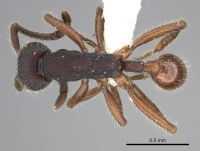Neivamyrmex asper
| Neivamyrmex asper | |
|---|---|

| |
| Scientific classification | |
| Kingdom: | Animalia |
| Phylum: | Arthropoda |
| Class: | Insecta |
| Order: | Hymenoptera |
| Family: | Formicidae |
| Subfamily: | Dorylinae |
| Genus: | Neivamyrmex |
| Species: | N. asper |
| Binomial name | |
| Neivamyrmex asper Borgmeier, 1955 | |
Photo Gallery
Identification
Face densely foveolate-granular, matte to slightly shiny; dorsum of postpetiole and first gastral tergite smooth and shining, contrasting with foveate-granular sculpture of petiole; in face view posterolateral margins of head without strongly produced triangular projections.
Distribution
Latitudinal Distribution Pattern
Latitudinal Range: 20.107° to 10.33333°.
| North Temperate |
North Subtropical |
Tropical | South Subtropical |
South Temperate |
- Source: AntMaps
Distribution based on Regional Taxon Lists
Neotropical Region: Costa Rica (type locality), Mexico.
Distribution based on AntMaps
Distribution based on AntWeb specimens
Check data from AntWeb
Countries Occupied
| Number of countries occupied by this species based on AntWiki Regional Taxon Lists. In general, fewer countries occupied indicates a narrower range, while more countries indicates a more widespread species. |

|
Estimated Abundance
| Relative abundance based on number of AntMaps records per species (this species within the purple bar). Fewer records (to the left) indicates a less abundant/encountered species while more records (to the right) indicates more abundant/encountered species. |

|
Biology
Jack Longino: This species occurs in Atlantic slope wet forest. At Tortuguero I found a colony inside a nasutiform termite nest. Workers were scattered throughout, but separate from the areas inhabited by termites. Brood occurred in spatially separated small batches of 10-20 larvae. In the Peñas Blancas Valley east of Monteverde, at 800m and 900m elevation, I twice observed nocturnal columns on the ground. During the ALAS expeditions on the Barva Transect, workers were obtained in a Winkler sample from the 500m site and a sweepnet sample from the 300m site.
Castes
Nomenclature
The following information is derived from Barry Bolton's Online Catalogue of the Ants of the World.
- asper. Neivamyrmex asper Borgmeier, 1955: 547 (w.) COSTA RICA.
- Type-material: 11 syntype workers.
- Type-locality: Costa Rica: Zent, 8.xii.1911 (W.M. Wheeler).
- Type-depositories: MCZC, MZSP.
- Status as species: Kempf, 1972a: 153; Watkins, 1976: 12 (in key); Bolton, 1995b: 287.
- Distribution: Costa Rica.
Description
References
- Borgmeier, T. 1955. Die Wanderameisen der neotropischen Region. Stud. Entomol. 3: 1-720 (page 547, worker described)
- Borowiec, M.L. 2019. Convergent evolution of the army ant syndrome and congruence in big-data phylogenetics. Systematic Biology 68, 642–656 (doi:10.1093/sysbio/syy088).
- Cantone S. 2017. Winged Ants, The Male, Dichotomous key to genera of winged male ants in the World, Behavioral ecology of mating flight (self-published).
References based on Global Ant Biodiversity Informatics
- Dattilo W. et al. 2019. MEXICO ANTS: incidence and abundance along the Nearctic-Neotropical interface. Ecology https://doi.org/10.1002/ecy.2944
- Longino J. T. 2013. Ants of Nicargua. Consulted on 18 Jan 2013. https://sites.google.com/site/longinollama/reports/ants-of-nicaragua
- Longino J. et al. ADMAC project. Accessed on March 24th 2017 at https://sites.google.com/site/admacsite/


